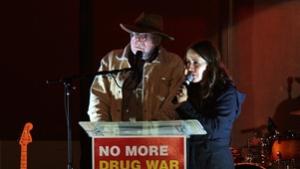The Drug Policy Alliance's 2011 International Drug Policy Reform Conference was staggering in its breadth and depth. Here's our first report.
A panel at the International Drug Policy Reform Conference last week called on Americans to take action to help end the drug war in Mexico, even as Human Rights Watch releases as a damning report on government killings, tortures, and disappearances in the drug war.
The US drug arrest rate has been declining slightly for the last four years, but is still more than double the rate at the beginning of Reagan's war on drugs in 1980, an analysis of FBI crime data has found.
Kalamazoo has become the first Michigan city to pass an initiative making small time marijuana use or possession by adults the lowest law enforcement priority.
Voters in Tacoma, Washington, approved a lowest law enforcement priority marijuana initiative Tuesday.
An effort to put marijuana legalization on the November 2012 ballot has passed a first hurdle in Missouri.
Sleazy, sleazy. That's what a Missouri drug court monitor is accused of being, plus we have a crooked Puerto Rican cop and a sticky-fingered Louisiana narc.
The ugliness continues unabated in Mexico, and another blogger has joined the ranks of the murdered.
Coffee shops in Holland's south will soon be closing their doors to foreigners, and the rest of the country is set to follow in another year.
Bolivia has restored diplomatic relations with the US after throwing out the DEA and the US ambassador three years ago, but the DEA is not welcome back.
Events and quotes of note from this week's drug policy events of years past.
For three days last weekend, the towering Westin Bonaventure Hotel in downtown Los Angeles was awash with drug reform activists running from presentation to presentation and chatting in hallway confabs while discussing myriad topics on the streets outside. It was the Drug Policy Alliance's 2011 International Drug Policy Reform Conference, and it was the largest yet, with more than 1,200 people from around the country and the world in attendance.

conference plenary session (photo courtesy HCLU, drogireporter.hu/en)
Police officers from Brazil and the US (mainly members of
Law Enforcement Against Prohibition) mingled with drug user activists from Latin America and Europe, college kids from
Students for Sensible Drug Policy sat down with grizzled veteran activists, former drug war prisoners discussed issues with elected officials, Southeast Asian harm reductionists swapped stories with American social workers, East European AIDS workers talked shop with their counterparts from the US and Canada, Mexican poets shared panels with American city council members. And medical marijuana and pot legalization activists, especially from host state California, were everywhere.
In all, people from more than 30 countries and probably every state in the union, representing dozens of different drug reform, harm reduction, human rights, reproductive rights, and other groups flooded into Los Angeles to get the latest skinny on drug reform, drug legalization, and ending drug prohibition.
The reform conference is so large and the issues so complex and interconnected that for a single person to attend all the sessions would require an army of clones. Over the three-day conference, five or six fascinating panels went on simultaneously throughout the day, not to mention the mobile workshops (medical marijuana, Skid Row, juvenile justice) taking attendees on themed city tours, the open rooms where various groups maintained a continuous presence, the evening events, and, last but not least, the Thursday night "End the Drug War" rally in MacArthur Park that drew several thousand people.
Some highlights follow.
Republican Presidential Candidate Gary Johnson
In the conference's opening plenary session, former New Mexico
Gov. Gary Johnson, who is struggling to gain traction in the Republican presidential nomination contest, found a friendly audience and threw it some red meat. Marijuana should be legalized and pot prisoners freed, he said to loud cheers and applause.
Johnson, who has been an advocate of drug legalization since his days as governor, said it was his stance on drug reform, rather than his record as governor or his advocacy of small government, that gets him noticed. "That's the marijuana guy," people always say when they see him, he said.

California NAACP president Alice Huffman (courtesy HCLU)
Politicians are behind the curve when it comes to drug reform, Johnson said. "Fifty percent of Americans support legalizing marijuana," he said. "But zero percent of the universe of politicians support this." Certainly not his Republican rivals, who look at the drug wars ravaging Mexico and compete to see who can sound tougher. "They all talk about border violence and adding guns to the equation instead of looking at the root of the problem, which is prohibition," he said.
The only other Republican presidential contender to take a firm line on ending the drug war is Texas Rep. Ron Paul. But Paul and Johnson together are only polling at about 10% of the Republican electorate, with Paul polling the majority of that. Johnson said he was concentrating on the New Hampshire primary, where he hopes a strong showing can keep his candidacy and his strong anti-drug war message alive.
[DRCNet Foundation and the Drug War Chronicle do not take positions on candidates. As a precaution, this article was produced by StoptheDrugWar.org's lobbying arm, Drug Reform Coordination Network.]
Mexico's Symbol of Drug War Resistance Tells Us It's Our Fight, Too
Read our feature story on this
here.
Whither Medical Marijuana?
In the context of renewed federal repression aimed at medical marijuana production and distribution, not just in California, but in medical marijuana states around the country, panels on the future of medical marijuana understandably generated great interest. A nationally-focused panel noted that the Justice Department has not explained itself and its apparent change of heart, nor has it given any indication whether the raids and other actions against medical marijuana will continue, stop, or escalate.
Meanwhile, a second, California-centric panel worried about medical marijuana's future in the Golden State and bruited about ideas about how best to preserve it.
"There is a historic backlash against medical marijuana, and that is a result of our success," said Don Duncan, Southern California leader for
Americans for Safe Access. "We made a strategic decision to go to localities, but now is the time to go back to Sacramento because we could lose ground in the towns. It is time for the legislature to adopt statewide regulations to protect safe access," he said.

Mikki Norris and Chris Conrad at Thursday's rally and concert in Macarthur Park (courtesy HCLU)
"We need to authorize storefront distribution, protect cultivators, and protect the civil rights of patients," Duncan continued, citing housing discrimination, employment problems, and custody issues.
But it's going to be a tough battle in Sacramento, he suggested. "Even the Democrats say the dispensaries are out of control, the patients don't look sick, the doctors are too lenient," he said. "Our base of support in Sacramento is eroding."
"I will call out my own party," said Assemblyman Tom
Ammiano (D-San Francisco). "It's time to get militant. There is a pro-marijuana vote, it's bipartisan, and it's populist."
There is support for medical marijuana on the right side of the aisle in Sacramento, too. "Very few, even in my party, still believe in Reefer Madness," said Assemblyman Chris
Norby (R-Orange County).
Pending California Marijuana Initiatives
A session on pending California marijuana legalization, decriminalization, and medical marijuana initiatives was useful for sorting out the competing proposals, with representatives of all serious proposals at the table. Here they are:
The
Repeal Cannabis Prohibition Act would simply repeal the sections of California law prohibiting marijuana. It would also create a California Cannabis Commission to create a system of regulated cannabis commerce.
"If conduct is not prohibited, the feds cannot force a state to prohibit it," said Joe
Rogoway, one of the initiative's sponsors. "This initiative eviscerates cannabis prohibition in California, all the laws would be wiped off the books," he said.
The
Regulate Marijuana Like Wine initiative would also repeal marijuana prohibition and set up a system of regulated distribution. It mandates the Department of Alcoholic Beverage Control to set up regulations for sales by 2013. It is sponsored by, among others, long-time Libertarian and legalization activist Steve
Kubby and retired Orange County Superior Court Judge Jim Gray.
"We've done our homework," said Gray. "We address those things that scare voters. We will have 10,000 valid signatures in two weeks," he vowed.

conference audience (courtesy HCLU)
Unlike the two legalization initiatives above, political consultant Bill Zimmerman's
Marijuana Penalties Act would not legalize it, but would extend California's current decriminalization of up to an ounce to up to two ounces.
"California is not ready to legalize marijuana," argued Zimmerman, "but a strong majority agree that private adult use should not result in jail time. It seems sensible to try to move the ball forward this year."
Then there is the
California Economic, Environmental, Hemp Restoration Act of 2012, a project of the Budget Economic Environmental Protection Alliance, which would legalize industrial hemp, medical marijuana, and recreational marijuana for people 21 and over. This initiative is still in the drafting phase.
"We want to create green jobs now," said initiative promoter Mark O'Hara. "Let's legalize industrial hemp and adult marijuana."
Finally, the folks who brought you Proposition 19, the
California Coalition for Cannabis Policy Reform, have decided to forego another legalization bid for 2012, and are instead working on an initiative to regulate medical marijuana statewide.
"We want to create a robust environment for our members," said
United Food and Commercial Workers (
UFCW) cannabis division head Dan Rush. "Our initiative isn't done yet, but we want to be inclusive, serve people, the industry, and patients."
Rush was the only one to mention the 800-pound gorilla in the room: the mountain of cash it will take for any of the initiatives to make the ballot, let alone win in November 2012.
"We need to raise $15 million for the initiative and legislative action," he said. "We need a broad coalition beyond our movement."
More to ComeThis article has touched on only a tiny fraction of what was discussed in Los Angeles last weekend. Look for more about and/or inspired by the conference in the near future. In the meantime, the Drug Policy Alliance deserves praise for once again putting together a reform conference that is staggering in its breadth and depth, and, as just about everyone agreed, maximally inspirational.
back to top
At the 2011 International Drug Policy Reform Conference in Los Angeles last weekend, one of the more heart-wrenching sessions focused on the prohibition-related violence in Mexico, where somewhere north of 40,000 people have been killed since Mexican President Felipe Calderon sent in the army to wage war on the cartels in December 2006. A panel of Mexican politicians, activists, and journalists led by poet Javier Sicilia -- and El Paso City Councilwoman Susie Byrd -- examined the roots and consequences of Mexico's war on drugs and called eloquently on Americans to take action to stop the carnage.

Javier Sicilia addressing conference, with translator Ana Paula Hernandez (photo courtesy HCLU, drogriporter.hu/en)
Mexican journalist Diego
Osorno, author of a book on the
Sinaloa Cartel, explained how Calderon took power amidst mass mobilizations and turmoil after a closely contested election in which his foe refused to accept defeat. "Calderon took power amidst political and social crisis,"
Osorno explained. "He began the
militarization using the pretext of drugs," he said.
The next panelist, former Mexican congressman Victor
Quintana of Chihuahua (where
Ciudad Juarez is located) looked at what Mexico's drug wars had done to his home state. "In Chihuahua, we had 407 people killed in 2007," he said. "In 2010, that number was 5,200. If the US had the same murder rate, that would be 400,000 dead in one year," he said.
"There has been an authentic genocide committed in our state,"
Quintana continued. "We have 10,000 drug war orphans and 230,000 people internally displaced. We face not only the violence of organized crime, but the violence of the state."
A report released Wednesday by
Human Rights Watch makes clear just what
Quintana was talking about when it comes to the violence of the state. The 212-page report,
Neither Rights Nor Security: Killings, Torture, and Disappearances in Mexico's "War on Drugs," portrays systematic human rights abuses committed by Mexican government forces, including dozens of documented killings.
Human Rights Watch officials visited Mexico this week to deliver copies of the report to Calderon, members of the Mexican Congress, the Supreme Court, and civil society groups.
"Instead of reducing violence, Mexico's 'war on drugs' has resulted in a dramatic increase in killings, torture, and other appalling abuses by security forces, which only make the climate of lawlessness and fear worse in many parts of the country, said
José Miguel
Vivanco, Americas director for the organization.
Like other panelists at the conference in Los Angeles,
Quintana took pains to make clear that Mexico's tragedy was tied to the US and the way we deal with the drugs we love to hate (or hate to love). "This is a bi-national war," he said. "America sends the guns and money, and Mexico gets the deaths."
Prohibition is a godsend to the cartels, said El Paso city councilwoman Byrd, who explained how a pound of marijuana sells for $25 in Mexico's pot-growing areas but $525 in Chicago. "Legalizing marijuana is the best way to take it to the cartels," she said.
Ciudad Juarez is "the epicenter of pain and tragedy, but also the epicenter of resistance," said
Zulma Mendez, a bi-national El Paso university professor and
Ciudad Juarez activist. The resistance has an agenda calling for demilitarization, justice and truth, and re-founding the city in a more human form, she said.
Zuma, too, called on Americans to act. "The bloodshed here is related to Plan
Merida," she said. "US taxpayers are funding this to the tune of $2.5 billion. People in the US should demand an end to Plan
Merida. US citizens can demand drug reform and revision of weapons policies and immigration and asylum policies," she challenged.
But it was gruff-voiced, cowboy hat-wearing Javier
Sicilia who proved most powerful. A poet and journalist who became the voice of resistance after his son and five others were murdered in
Cuernavaca earlier this year,
Sicilia has led caravans of protestors across Mexico to demand truth and justice and an end to the violence.
"Who is being held accountable?" he asked, complaining of a culture of impunity, and not just in Mexico. "Where is the money being laundered, and not just the drug money, but the money from other crimes? Money is the blood of the poor. We have 50,000 dead and 10,000 disappeared. The word to describe this would be 'demonic.' We are all responsible for these crimes against humanity because they are done by our governments," he said.
"If we were to put a human face on the suffering, it would be something we could not bear,"
Sicilia continued. "This is the image of our country: A six-year-old orphaned boy waiting for us on the road, holding a photo of his father, who had been killed and returned in a blanket. The face of that orphan is the face of our country. In a century when we talk of human rights, that is the tragedy."
The Mexico session wasn't the only place
Sicilia made his voice heard. He also appeared before the crowd at a boisterous anti-drug war demonstration in MacArthur Park Thursday night and at the final plenary session of the conference. Then it was back to Mexico and the quest for peace and justice.
back to top
The arrest rate for drug violations in the US has decreased for the last four years, but still remains more than twice as high as rates in the early 1980s, the University of Maryland's Center for Substance Abuse Research (CESAR) reported Monday. The finding was based on analysis of data from the FBI's Uniform Crime Reporting program.

drug bust (wikimedia.org)
According to CESAR's analysis, last year, there were 530.8 drug arrests per 100,000 US residents, down 15.6% from the all-time high of 632.9 in 2006. Overall drug arrests have declined all four years since then.
Of the 2010 drug arrests, 18% were for sale or manufacture and 82% were for drug possession. More than half of all drug arrests were for marijuana violations. CESAR will report next week on trend data for the types of drugs that have resulted in drug arrests for the past 30 years.
While the drug arrest rate is declining, drug arrests still accounted for more than 1.6 million busts last year.
The drug arrest rate per 100,000 was at about 250 in 1980 before shooting up to more than 500 in 1989 as the Reagan-era drug war blossomed. The arrest rate dipped to around 400 in the early
1990s, but went over 500 in 1994 and has remained above that mark ever since. After declining slightly in 2002, arrest rates steadily increased at mid-decade, going over 600 in 2005, 2006, and 2007, before sliding under 600 in 2008 and declining slightly since then.
back to top
Voters in Kalamazoo, Michigan, overwhelmingly approved a ballot initiative making the use or possession of small amounts of marijuana by adults the lowest law enforcement priority. The measure passed by a margin of nearly two-to-one, with 4,649 yes votes and 2,416 no votes.
Similar measures have passed in a number of cities around the country since Seattle led the way in 2003, but Kalamazoo is the first Michigan locale to do so.
The question before the voters was: "Shall the Kalamazoo City Charter be amended such that the use and/or consumption of one ounce or less of usable marijuana by adults 21 years or older is the lowest priority of law enforcement personnel?"
The measure passed easily despite the opposition of Michigan's governor and attorney general. Local officials said passage of the measure won't change much. "The proposed charter amendment has no bearing or standing relative to the enforcement of state or federal law, which our officers have the full authority to enforce," Kalamazoo Department of Public Safety Chief Jeff Hadley told the
Kalamazoo Gazette last month.
Still, the effort led by the
Kalamazoo Coalition for Pragmatic Cannabis Laws has made clear to elected officials just where the local electorate stands on the issue. As Hadley's comment shows, activism does not end when a law gets passed.
back to top
Voters in Tacoma, Washington, overwhelmingly approved an initiative Tuesday directing the city to make adult marijuana possession offenses the lowest law enforcement priority. The measure passed by a margin of 65% to 35%.
Organized under the auspices of the
Cannabis Reform Act for the City of Tacoma, the
initiative, known as I-1, directs Tacoma police and prosecutors to "make the investigation, arrest, and prosecution of cannabis (a/k/a 'marijuana') offenses the lowest enforcement priority, as this term may be defined in their policies and procedures manuals, for adult personal use."
Supporters of the initiative included medical marijuana patients, who argued that it would allow sick people in Tacoma to use their medicine without fear of legal consequences. Supporters also argued that the implementation of the measure would free up law enforcement resources for more serious matters.
But Tacoma prosecutors and law enforcement officials said the new law wouldn't change much. They said marijuana possession offenses aren't a priority now.
Tacoma is following in the footsteps of Seattle, just a few miles north on Interstate 5, which passed a lowest priority initiative in 2003. While Seattle saw hundreds of annual pot possession arrests before passing its initiative, that number dropped to dozens after it passed. Since City Attorney Pete Holmes took office last year, there has been just one prosecution for simple marijuana possession.
In Tacoma, by contrast, 463 marijuana possession cases were prosecuted last year -- so much for their not being a priority -- and 159 so far this year. Initiative proponents said Tacoma could do better by doing less when it comes to prosecuting pot possessors.
back to top
Missouri Secretary of State Robin Carnahan announced Monday that two initiatives for marijuana legalization measures have been approved for circulation. Both were filed by attorney Dan Viets, a long-time marijuana legalization advocate and a member of the national NORML Legal Committee and board of directors.
Viets and Missouri
NORML chapters have aligned themselves with other marijuana legalization advocates and supporters as
Show-Me Cannabis Regulation, a reference to Missouri's nickname as the "Show Me" state.
The two measures are identical, except that one would amend the state constitution and the other would amend state law.
The initiatives call for marijuana legalization for persons 21 and over, a process for licensing marijuana establishments, and the lifting of criminal justice system sanctions against people imprisoned or under state supervision for nonviolent marijuana offenses that would no longer be illegal and the expunging of all criminal records for such offenses. The initiatives would also allow for the use of marijuana for medical reasons by minors and allow the legislature to enact a tax of $100 a pound on retail marijuana sales.
The initiatives now move on to the signature-gathering phase. To qualify for the November 2012 ballot, the constitutional amendment initiative must obtain the signatures of a number of registered voters equal to 8% of the total votes cast in the 2008 governor's race from six of the state's nine congressional districts. The requirements for the statutory amendment are slightly looser; it needs the signatures of 5% of the voters in those districts. Signatures must be turned in by May 6, 2012.
If marijuana legalization makes the ballot in Missouri next year, the state is likely to join Washington and Colorado in taking the issue before the voters. Efforts in those two states are the most advanced and likely to make the ballot, although there is a possibility that similar efforts could make the ballot in California and Oregon.
back to top
Sleazy, sleazy. That's what a Missouri drug court monitor is accused of being, plus we have a crooked Puerto Rican cop and a sticky-fingered Louisiana narc. Let's get to it:
In St. Louis, Missouri,
a former Lincoln County sheriff's deputy was indicted November 3 on federal charges he sexually abused five female drug court participants he was monitoring. Scott Edwards, 49, was a part-time tracker for the drug court program between February 2009 and November 2010. He had sexual contact with three of the victims and "engaged in acts that resulted in bodily injury and included aggravated sexual abuse" with two others, according to the indictment. He also allegedly "restrained and confined one of the female victims by force, intimidation, and deception." He faces five civil rights-related charges: two felony counts of deprivation of rights under color of law including aggravated sexual abuse, one felony count of deprivation of rights under color of law including kidnapping, and two misdemeanor counts of deprivation of rights under color of law including sexual contact. An attorney for the five women said Edwards threatened them with jail time if they didn't have sex with him, used drug court funds to rent hotel rooms so he could have easier access to them, and that when the women complained to drug court team members, they were ignored.
In San Juan, Puerto Rico,
a former Puerto Rico police sergeant was sentenced November 4 to 12 ½ years in federal prison after pleading guilty to conspiring to import drugs from Colombia aboard ships. Victor
Esquilin Rosa had also been charged with providing protection to drug traffickers who visited the US Caribbean territory.
Esquilin is the latest of dozens of Puerto Rico police officers accused of drug trafficking in recent years.
In
Bastrop, Louisiana,
a Morehouse Parish Sheriff's office narcotics deputy has resigned following an audit that found what the sheriff called "a very small amount of funds" missing from an account used to purchase drugs from unsuspecting dealers. Lt. Chris
Balsamo, a 14-year veteran with the department, submitted his resignation Tuesday. The sheriff said $100 was missing from a safe where money to make buy-bust cases was kept. An internal investigation is ongoing and its results will be forwarded to the 4
th Judicial District Attorney's Office for review.
back to top
by Bernd Debusmann Jr.
Mexican drug trafficking organizations make billions each year smuggling drugs into the United States, profiting enormously from the prohibitionist drug policies of the US government. Since Mexican president Felipe Calderon took office in December 2006 and called the armed forces into the fight against the so-called cartels, prohibition-related violence has killed around 40,000 people, including more than 15,000 last year. The increasing militarization of the drug war and the arrest or killing of dozens of high-profile drug traffickers have failed to stem the flow of drugs -- or the violence -- whatsoever. The Merida initiative, which provides $1.4 billion over three years for the US to assist the Mexican government with training, equipment and intelligence, has so far failed to make a difference. Here are a few of the latest developments in Mexico's drug war:
Tuesday, November 1
In a swamp near Veracruz, an
anonymous tip led to the discovery of eight bodies. The area where the bodies were found is near
Bocas del Rio, where 35 bodies were dumped in September.
Wednesday, November 2
In La
Piedad,
Michoacan,
town Mayor Ricardo Guzman, 45, was shot and killed. Guzman was handing out campaign flyers outside a restaurant when a gunman in a black SUV shot him once with a pistol. He was a member of President Calderon's PAN party.
In March, La
Piedad police chief Jose Luis Guerrero was killed by gunmen with
AK-47s. His successor was later attacked by up to 40 gunmen traveling in a ten-car convoy, but survived.
In Saltillo,
Coahuila, at
least three people were killed during a series of fire fights which took place in several locations around the city. Two of the dead were police officers. The fighting began between two groups of rival traffickers in the afternoon. Later in the day, students at a local university were trapped during a gun battle between Marines and unidentified gunmen.
Thursday, November 3
In Mexico City,
SEDENA announced that 14 soldiers were convicted and given prison sentences for the shooting deaths of three children and two women who were killed at a checkpoint in
Sinaloa in 2007. The commanding officer was given a 40-year sentence, and another officer given a 38-year sentence while 12 enlisted soldiers were given 16-year sentences.
Near Mexico City,
a high-ranking member of the La Borradora Organization was captured by police. Victor Manuel Rivera
Galeana, "Victor el
Gordo," 35, is thought play a large role in his organization’s battle for control of retail drug sales and criminal activities in the Acapulco area.
In
Ciudad Juarez,
six gunmen were killed during a massive fire fight between groups of rival criminals. Two of the gunmen were killed in a car with Texas plates. Over 400 bullet casings were recovered after the battle.
Friday, November 4
In
Culiacan,
11 people were killed in two separate incidents. In one of the incidents, eight people gathered at a volleyball court were killed when gunmen descended from several vehicles and opened fire on them with automatic weapons.
In another part of the same city, two men and a woman were gunned down. The killings are all thought to be related to the recent killing of
Sinaloa Cartel enforcer Francisco "
Pancho"
Arce, who was said to be responsible for the murder of a nephew of Juarez Cartel boss Vicente
Carillo Fuentes in
Sinaloa not long ago.
In Hidalgo, Texas,
two alleged Gulf Cartel members were arrested and charged in connection with an attempted kidnapping that occurred on Tuesday. The victim was rescued from the trunk of a car as the men attempted to smuggle him into Mexico. According to police, the men were attempting to recover a 1,500 pound narcotics shipment that had gone missing. Several other suspects are still being sought.
Saturday, November 5
In
Guamuchil,
Sinaloa,
three bodies were left hanging from an overpass. At least one of the victims had been tortured before being killed. The other two appear to have been stored in a freezer until being dumped.
Sunday, November 6
In Veracruz,
the offices of local newspaper El Bueno Tono were torched after gunmen stormed the building and told employees to flee. Nobody was injured in the incident, which involved at least 10 hooded and heavily armed men.
Monday, November 7
In Tijuana,
an Arellano-Felix Cartel boss was captured after he opened fire on a car carrying two rival traffickers. Juan Francisco
Sillas Rocha, "El
Ruedas," 34, is thought have reported directly to cartel boss Fernando "The Engineer" Sanchez
Arellano.
Sillas is thought to have played a large part in the
AFO's fight with the
Sinaloa Cartel between 2007 and 2009 and is alleged to have masterminded the kidnapping of three women tied to
Sinaloa Cartel figure
Ismael "El Mayo"
Zambada in 2010.
In
Sinaloa, the
mayor of the tourist town of Mazatlan was unhurt when his car was ambushed by gunmen on the highway to
Culiacan. Alejandro
Higuera Osuna was traveling in a convoy with his bodyguards when they were ambushed by at least ten men who had been hiding in the brush.
In
Ciudad Juarez,
the dismembered bodies of two men were left on a busy street. Their heads were inside two coolers. A note, whose contents have not been revealed, was left with the bodies.
Wednesday, November 9
In Nuevo Laredo,
a blogger was found beheaded. The man, so far only identified by his online moniker "Fiddler", was a moderator on the blog "Nuevo Laredo en Vivo". His body was left with a note which said that he had "failed to understand I must not report on social networks."
Editor's Note: We can no longer tally this year's drug war deaths in Mexico with accuracy. The figure for this year's deaths is an estimate, no more, until there is some official toll reported.]
Total Body Count for 2007 (
approx.): 4,300
Total Body Count for 2008 (
approx.): 5,400
Total Body Count for 2009 (
approx.): 9,600
Total Body Count for 2010 (official): 15,273
Total Body Count for 2011: (
approx.): 8,500
TOTAL: > 42,000
back to top
No one other than Dutch residents will be allowed to buy marijuana in southern Holland cannabis coffee shops after January 1, the Dutch Justice Ministry said Tuesday. The stated objective of the move is to spare locals the nuisance of drug tourism, but if the experience of one city is any indicator, it will also spare locals millions of dollars in receipts.

coffee shop in Amsterdam (wikimedia.org)
For more than a year, the center right government of Prime Minister Mark
Rutte has been considering making coffee shops members only clubs, with a "cannabis card" reserved for Dutch nationals required to enter one of the country's 670 cannabis cafes. The new policy is being rolled out regionally, with southern border provinces the first to see it go into effect.
"The measure will come into force for the provinces of
Limburg,
North-Brabant and
Zeeland, the provinces most affected by drug tourism, on January 1," Justice Ministry spokeswoman Charlotte
Menten said.
The new policy will be extended nationwide in January 2013,
Menten added.
The southern city of
Maastricht holds some clues as to what impact the new policy will have. In a pilot program since October 1, the city's 13 cannabis cafes have been allowed to serve only Dutch, Belgian, and German customers in a bid to reduce drug tourism from France. The
Daily Telegraph reported this week that cutting off the French will cost the city nearly $42 million a year in revenues, the equivalent of the loss of 345 full-time jobs.
back to top
The US and Bolivian governments announced Monday that they were restoring diplomatic relations after three years, but Bolivian President Evo Morales Tuesday made it clear that DEA agents would not be welcome back in his country.

Evo Morales (wikimedia.org)
Relations between the two countries went into the deep freeze after Bolivia threw out US Ambassador Phillip Goldberg and the DEA in September 2008, charging they were interfering in domestic Bolivian political affairs. Now, in an accord signed Monday, the two countries agreed to exchange ambassadors and to undertake close cooperation in anti-drug efforts, trade and development.
That anti-drug cooperation will not include DEA agents in Bolivia,
Morales told reporters at a regional conference in Bogota. It was a matter of national "dignity and sovereignty," he said, adding that he was "personally a victim" because Bolivian anti-drug police worked closely with the DEA. Those same police had clashed with coca growers and once beat him unconscious, he has said. Morales was a coca grower union leader before he was elected president.
"They repressed us in Bolivia. That has ended," Morales said. "For the first time since Bolivia was founded, the United States will now respect Bolivia's rules" and laws under the new diplomatic agreement, he added.
Coca has been grown for centuries, if not millennia, in Bolivia. The country is currently the world's third largest coca producer, behind Peru and Colombia. While much of the crop is destined for traditional or industrial uses, some is diverted to the illicit cocaine market.
US officials have said they believe cocaine trafficking is on the increase since Bolivia expelled the DEA, but that is not reflected in an expansion of the coca fields. According to the United Nations, the amount of land under coca cultivation increased only 0.3% last year.
back to top
November 15, 1875: San Francisco passes the first US anti-drug law, an ordinance outlawing Chinese opium dens.
November 12, 1970: Keith
Stroup forms the National Organization for the Reform of Marijuana Laws (
NORML).
November 12, 1980: New York City Mayor Ed Koch admits to having tried marijuana.
November 15, 1984: Spanish police arrest Jorge Ochoa on a US warrant and both the US and Colombia apply for his extradition. Soon after, the
Medellin cartel publicly threatens to murder five Americans for every Colombian extradition. The Spanish courts ultimately rule in favor of Colombia's request and Ochoa is deported. He serves a month in jail on charges of bull-smuggling before being paroled.
November 11, 1988: The Anti-Drug Abuse Act establishes the creation of a drug-free America as a policy goal. A key provision of the act is the creation of the Office of National Drug Control Policy (
ONDCP) to set priorities, implement a national strategy, and certify federal drug-control budgets.
November 10, 2001: The Austin American-Statesman reports that police publicly apologized to Maria Flores for a botched drug raid on May 16.
November 15, 2001:
Asa Hutchinson, administrator for the Drug Enforcement Administration, and Republican
Gov. Gary Johnson of New Mexico debate the war on drugs in front of about 150 people in Yale's Law School auditorium.
November 15, 2002: NFL star and
NORML advisory board member Mark
Stepnoski is interviewed on the
O'Reilly Factor.
back to top













